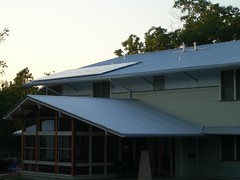Goin' Solar
We've finally gotten our planned solar panels (photovoltaics or "PVs" to those in the know) installed, although they are not quite hooked into the house electrical system and will need to be inspected by the city before they can be turned on.
The system is a 3.3kW system, meaning that it's maximum output is 3300 watts DC at any given moment. The official rating is 2.56 kW to the grid to account for the loss when converting from DC to AC current. This system should produce about 4500 kilowatt hours per year, or roughly 20 percent of our total energy requirements per year. Of course one cool thing about PVs is that they produce the most electricity when A/C demand is highest, so it will have a disproportionately positive value in terms of reducing demand on the grid when the grid is under greatest load.
The system is tied into the grid which means that it can only operate when the grid is operating, so if there is a power outage we are still without power--this is for the safety of the people restoring the power. This also means that the city buys back any excess power we produce (at some discounted rate), so it is possible for our meter to run backwards.
I also checked our usage for April, the first full month in the house. We averaged 27 kWh per day. By comparison, our old house, which is 1/2 the size of our current house, used 25 kWh per day for the same period last year (which was a little cooler as well). So that's pretty good.
The PV system is sized to maximize our rebate from the city (and is also as much as we could afford to put up given our cash reserves (and we could only afford it at all because of the adoption expense tax credit, which essentially refunded us the cost of the system)). As you can see from the picture we could have a system four or five times as large and probably supply most, if not all, of our electricity needs. Of course a system like that would cost close to 100K (no rebate to offset the additional cost). Maybe if PV cost drops significantly in the next 10 years (which it should) we can do that.
As it is we expect about a 15-year payback on the system based just on saved electricity at current electrical rates. Of course we can expect electrical costs to go up over that time, so maybe the payback will be closer to 10 years. But you can't really see it as an investment but as The Right Thing To Do.
But what I really want is a plug-in hybrid and another PV system on the garage used to charge it so that we can have a solar-powered car....










0 Comments:
Post a Comment
<< Home